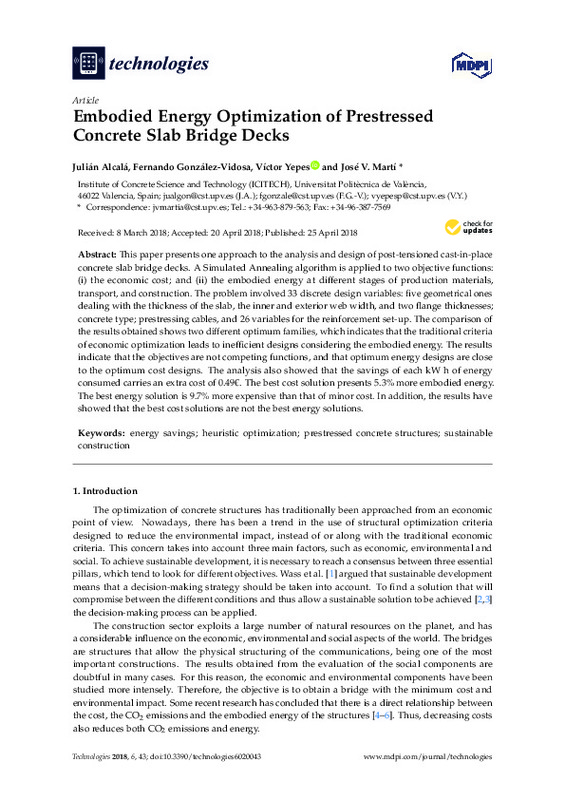JavaScript is disabled for your browser. Some features of this site may not work without it.
Buscar en RiuNet
Listar
Mi cuenta
Estadísticas
Ayuda RiuNet
Admin. UPV
Embodied energy optimization of prestressed concrete slab bridge decks
Mostrar el registro sencillo del ítem
Ficheros en el ítem
| dc.contributor.author | Alcalá González, Julián
|
es_ES |
| dc.contributor.author | González Vidosa, Fernando
|
es_ES |
| dc.contributor.author | Yepes, V.
|
es_ES |
| dc.contributor.author | Martí Albiñana, José Vicente
|
es_ES |
| dc.date.accessioned | 2018-12-19T21:06:22Z | |
| dc.date.available | 2018-12-19T21:06:22Z | |
| dc.date.issued | 2018 | es_ES |
| dc.identifier.issn | 2227-7080 | es_ES |
| dc.identifier.uri | http://hdl.handle.net/10251/114250 | |
| dc.description.abstract | [EN] This paper presents one approach to the analysis and design of post-tensioned cast-in-place concrete slab bridge decks. A Simulated Annealing algorithm is applied to two objective functions: (i) the economic cost; and (ii) the embodied energy at different stages of production materials, transport, and construction. The problem involved 33 discrete design variables: five geometrical ones dealing with the thickness of the slab, the inner and exterior web width, and two flange thicknesses; concrete type; prestressing cables, and 26 variables for the reinforcement set-up. The comparison of the results obtained shows two different optimum families, which indicates that the traditional criteria of economic optimization leads to inefficient designs considering the embodied energy. The results indicate that the objectives are not competing functions, and that optimum energy designs are close to the optimum cost designs. The analysis also showed that the savings of each kW h of energy consumed carries an extra cost of 0.49Euro. The best cost solution presents 5.3% more embodied energy. The best energy solution is 9.7% more expensive than that of minor cost. In addition, the results have showed that the best cost solutions are not the best energy solutions. | es_ES |
| dc.description.sponsorship | The authors acknowledge the financial support of the Spanish Ministry of Economy and Competitiveness, along with FEDER funding (Project: BIA2017-85098-R). | |
| dc.language | Inglés | es_ES |
| dc.publisher | MDPI AG | es_ES |
| dc.relation.ispartof | Technologies | es_ES |
| dc.rights | Reconocimiento (by) | es_ES |
| dc.subject | Energy savings | es_ES |
| dc.subject | Heuristic optimization | es_ES |
| dc.subject | Prestressed concrete structures | es_ES |
| dc.subject | Sustainable construction | es_ES |
| dc.subject.classification | INGENIERIA DE LA CONSTRUCCION | es_ES |
| dc.title | Embodied energy optimization of prestressed concrete slab bridge decks | es_ES |
| dc.type | Artículo | es_ES |
| dc.identifier.doi | 10.3390/technologies6020043 | es_ES |
| dc.relation.projectID | info:eu-repo/grantAgreement/AEI/Plan Estatal de Investigación Científica y Técnica y de Innovación 2013-2016/BIA2017-85098-R/ES/DISEÑO Y MANTENIMIENTO OPTIMO ROBUSTO Y BASADO EN FIABILIDAD DE PUENTES E INFRAESTRUCTURAS VIARIAS DE ALTA EFICIENCIA SOCIAL Y MEDIOAMBIENTAL BAJO PRESUPUESTOS RESTRICTIVOS/ | es_ES |
| dc.rights.accessRights | Abierto | es_ES |
| dc.contributor.affiliation | Universitat Politècnica de València. Departamento de Ingeniería de la Construcción y de Proyectos de Ingeniería Civil - Departament d'Enginyeria de la Construcció i de Projectes d'Enginyeria Civil | es_ES |
| dc.description.bibliographicCitation | Alcalá González, J.; Gonzalez Vidosa, F.; Yepes, V.; Martí Albiñana, JV. (2018). Embodied energy optimization of prestressed concrete slab bridge decks. Technologies. 6(2):43-1-43-9. doi:10.3390/technologies6020043 | es_ES |
| dc.description.accrualMethod | S | es_ES |
| dc.relation.publisherversion | http://doi.org/10.3390/technologies6020043 | es_ES |
| dc.description.upvformatpinicio | 43-1 | es_ES |
| dc.description.upvformatpfin | 43-9 | es_ES |
| dc.type.version | info:eu-repo/semantics/publishedVersion | es_ES |
| dc.description.volume | 6 | es_ES |
| dc.description.issue | 2 | es_ES |
| dc.relation.pasarela | S\363972 | es_ES |
| dc.contributor.funder | Agencia Estatal de Investigación | es_ES |








